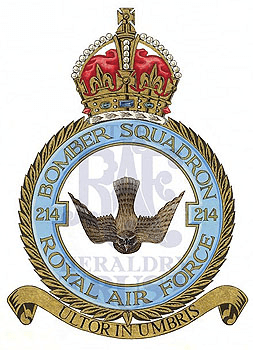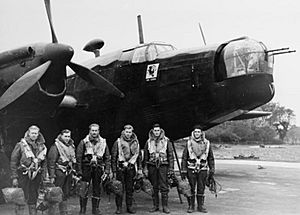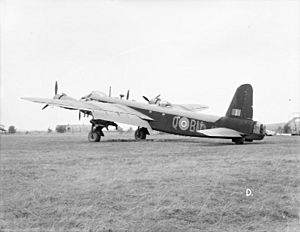No. 214 Squadron RAF facts for kids
Quick facts for kids No. 214 (Federated Malay States) Squadron RAF |
|
|---|---|
 |
|
| Active | 1917–1920 1935–1977 |
| Country | |
| Branch | |
| Nickname(s) | Federated Malay States |
| Motto(s) | Latin: Ultor in umbris ("Avenging in the shadows") |
| Insignia | |
| Squadron heraldry | A nightjar volant affrontée |
| Squadron codes | 214 (Jan 1937–Apr 1939) UX (Apr 1939–Sep 1939) BU (Sep 1939–Jul 1945) QN, PX* (Nov 1946–Apr 1951, *only used by "C" Flight) |
No. 214 Squadron was a special unit of the Royal Air Force (RAF). It flew many different types of aircraft during its time. The squadron was known for its bombing missions and later for its special electronic warfare tasks. It played an important role in both World War I and World War II.
Contents
History of No. 214 Squadron
Early Years: World War I
No. 214 Squadron started as part of the Royal Naval Air Service (RNAS). This was the air force of the British Navy. It was first called No. 14 Squadron RNAS. On 9 December 1917, it became No. 214 Squadron.
When the RAF was created on 1 April 1918, this squadron joined the new air force. It was later given the longer name No. 214 (Federated Malay States) Squadron.
The squadron first flew the Handley Page Type O/100 bomber plane. In mid-1918, it received the more powerful O/400. These planes were used to bomb important German targets during the war. From June to October 1918, the squadron was based at RAF Saint Inglevert.
Between the World Wars
After World War I, the squadron moved to Egypt. However, it was closed down on 1 February 1920. Its pilots and planes joined another unit, No. 216 Squadron RAF.
The squadron was started again on 16 September 1935. It was formed from a part of No. 9 Squadron RAF. This new No. 214 Squadron was also a bomber unit. It flew Vickers Virginia Mk. X night-bombers from RAF Boscombe Down.
World War II Missions
When World War II began, the squadron was flying Vickers Wellington planes. In 1942, they switched to the larger Short Stirling bombers. At this time, they were based at RAF Stradishall.
Later, the squadron moved to RAF Chedburgh. One pilot remembered seeing local people watching the planes take off. The large Stirling planes would move slowly along the airfield. Their target was often cities like Hanover in Germany.
By December 1943, Stirling planes were no longer used for bombing Germany. This was because too many of them were being lost. So, the squadron moved to RAF Downham Market.
In January 1944, the squadron changed its role. It joined No. 100 Group RAF for special missions. These missions involved electronic countermeasures. This meant they would use special equipment to help protect other bomber planes.
The squadron used Boeing Fortress Mk II and Mk III planes, along with some Stirlings. They used a system called "Airborne Cigar" (ABC). This system would jam German night fighter communications. German-speaking radio operators would pretend to be German ground controllers. They would try to send the enemy fighters away from the main group of bombers. Some of their B-17s also had 'Piperack' equipment. This helped to block the German Lichtenstein SN-2 radar used by enemy planes.
After the war, the squadron was formed again on 1 March 1948. It was based at RAF Aldergrove. It flew Handley Page Halifax GR.6 planes until 18 October 1948.
Post-War Operations
In July 1955, there were plans to form the squadron again. It was meant to be at RAF Laarbruch in West Germany. However, before it could be fully formed, the plans changed. The new squadron was instead named No. 80 Squadron RAF.
No. 214 Squadron did start up again on 21 January 1956. It flew Vickers Valiant planes from RAF Marham. These planes were part of the V bomber force, designed to carry nuclear weapons. Later, the Valiant planes were changed into tanker aircraft. Tankers refuel other planes in the air.
Leonard Trent, a brave pilot who won the Victoria Cross, was the first leader of the Valiant squadron. He was followed by Michael Beetham, who later became a very important leader in the RAF. The squadron was closed down in 1965. But it started again the next year, flying Handley Page Victor tanker planes. It continued to operate until it was finally closed for good in 1977.
Notable Incidents
- On 29 April 1937, two new Handley Page Harrows from RAF Feltwell crashed. They collided in the air over Wissington, Norfolk. Five airmen sadly lost their lives. Reports said that a wing of one plane hit the tail of the other. One plane crashed into a field and caught fire. The other crashed into the River Wissey.
- On 10/11 August 1943, Flight Sergeant Harry Ernest Hall was flying a damaged aircraft. It was returning from a mission after one engine stopped working. Near Bexhill, on the coast of England, the plane ran out of fuel. It crashed into the sea. The crew were knocked out for a short time. The plane quickly filled with water. F/S Hall was the first to recover. He immediately thought about his crew's safety. He found the wireless operator injured and helped him out of the plane. He made sure the operator was safe in a dinghy. He then went back into the sinking plane to look for two other missing crew members. Five crew members were later rescued by a boat. Two did not survive. F/S Hall showed great courage and calm during this very difficult situation. Sadly, F/S Hall was killed on another mission six weeks later. He was given the British Empire Medal for his bravery. His mother received the award for him after his death.
- On 19 August 1968, a Victor K1 plane, XH646, collided in the air. It crashed near Holt, Norfolk during bad weather. It hit an 213 Squadron English Electric Canberra plane, WT325. All four crew members on the Victor and all three on the Canberra died.



